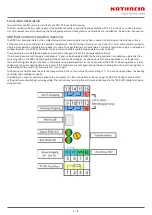
2 / 12
Safety and installation instructions
WARNING!
When carrying out installation work in locations where there is a risk of falling, take appropriate safety
precautions, e.g. use of a working platform. Make sure that the roof is sufficiently strong and stable to carry
out the installation work (risk of damage or collapse). There is also a risk of serious injuries due to falling
parts.
Make sure that:
▶ The connected devices are disconnected from the power supply.
▶ The person carrying out the installation or repair does not suffer from vertigo and can move around safely on the
roof.
▶ The person carrying out the installation or repair is wearing sturdy and non-slip footwear.
▶ The person carrying out the installation or repair has a secure position to stand and hold on while working.
▶ The roof and the climbing equipment used (e.g. ladder) are dry and non-slip.
▶ The roof can withstand the weight of the person carrying out the repairs.
▶ Nobody is below the antenna during installation/removal.
Installation and connection may only be performed by qualified specialist personnel.
To prevent hazards during installation and operation, the instructions and information provided must be strictly adhered to.
Proper installation and connection are prerequisites for compliance with the corresponding standards.
DANGER!
Risk of death due to electric shock in the event of contact with electrical equipment!
Correct performance of the installation and electrical connection is a crucial safety factor.
Observe the installation conditions and steps described as precisely as possible.
Modifications to the electrical installation may only be carried out by a specialist electrician. Do not make any modifica-
tions yourself.
Intended use
Do not use the ESO 99 S for any purposes other than that specified in these instructions. Any use other than that specified above will
invalidate the warranty or guarantee.
In particular,
never
:
•
Modify any of the components.
•
Use any components other than those explicitly specified by the manufacture for use with the ESO 99 S.
The ESO 99 S is used to control the ESO 120/124/180 H and ESO 124/180 HL reflector heaters and prevents snow, ice and frost from
building up on the antenna reflector surface. Any use other than that specified above will invalidate the warranty or guarantee.
The following circumstances result in the loss of all warranty and liability claims towards the manufacturer:
•
Improper installation
•
Use of non-specified fixing materials, which cannot guarantee mechanical stability
•
Non-permitted use
•
Structural changes or interference with the components and fixing accessories in the kit, which could jeopardise both the mechan-
ical stability and functional reliability
•
Use of cleaners containing solvents, such as acetone, nitro-cellulose combination thinner, petrol etc.
•
Failure to observe the installation and safety instructions in this manual





























